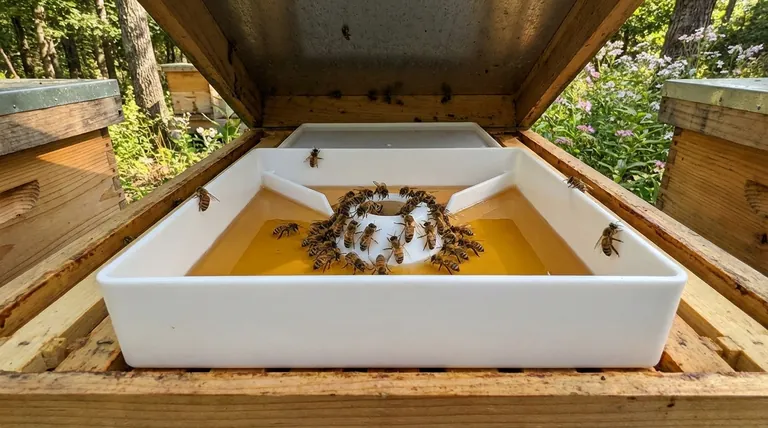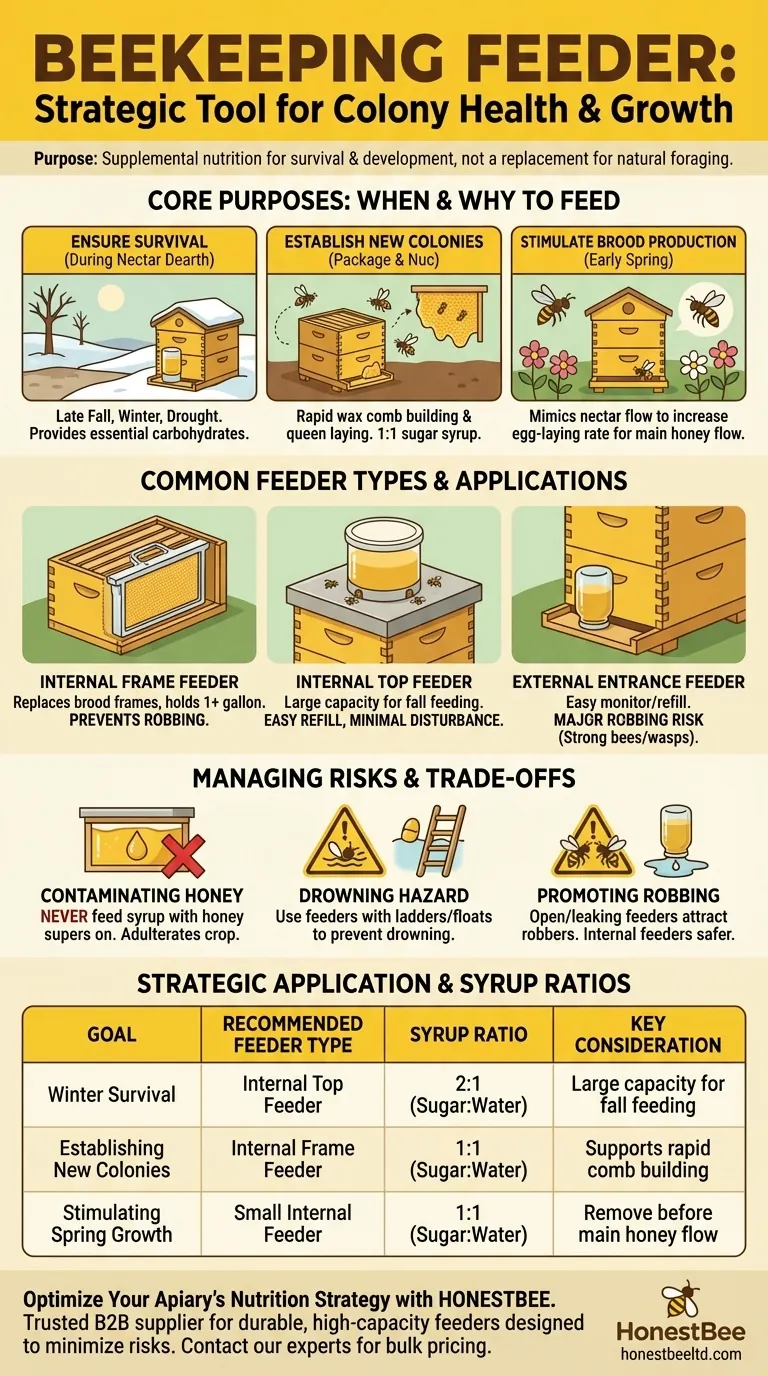In beekeeping, a feeder is a strategic tool for providing supplemental nutrition to a honey bee colony. It's a vessel used to deliver sugar syrup (as a honey substitute) or pollen substitutes when natural forage is unavailable. This intervention is critical for ensuring survival and promoting colony growth at specific times of the year.
The core purpose of a feeder is not to replace natural foraging, but to serve as a temporary support system. It's a deliberate management action used to help a colony overcome a nutritional deficit, establish itself, or prepare for the season ahead.

The Core Purpose: Why Feed Honey Bees?
Feeding is a response to a specific need within the hive. Understanding these needs is key to using a feeder effectively and not creating unintended problems.
Ensuring Survival During a Nectar Dearth
The most critical use of a feeder is to prevent starvation. A nectar dearth is any period when there are few or no blooming flowers, such as during late fall, winter, or a summer drought. During these times, a feeder provides the essential carbohydrates the colony needs to survive.
Establishing New Colonies
A newly installed package of bees or a small "nuc" colony has very few resources. They lack drawn comb, stored honey, and a large foraging workforce. Feeding them a 1:1 sugar-to-water syrup provides the energy they need to rapidly build wax comb and for the queen to begin laying eggs.
Stimulating Brood Production
In early spring, a beekeeper might lightly feed a colony to mimic an early nectar flow. This signals to the queen that resources are abundant, encouraging her to increase her egg-laying rate. The goal is to build a large population of forager bees just in time for the main honey flow.
Common Feeder Types and Their Applications
The type of feeder you choose depends on your goal, the season, and the strength of your colony. Feeders are broadly categorized as internal or external.
Internal Frame Feeders
These feeders are shaped like a frame and are placed inside the hive body, taking the place of one or two of the brood frames. They can typically hold a gallon or more of syrup.
Because they are inside the hive, they do a good job of preventing bees from other colonies ("robbers") from finding the food source.
Internal Top Feeders
A top feeder is a container placed on top of the uppermost hive box, directly under the main hive cover. Bees access the syrup from below through a screened opening.
This design allows for refilling with minimal disturbance to the colony and often has a large capacity, making it excellent for fall feeding.
External Entrance Feeders
These are typically a simple inverted jar with small holes in the lid, placed at the hive's entrance. They are very easy to monitor and refill.
However, their position at the entrance makes them a major attractant for robbing bees and wasps, which can be a significant danger to a weak colony.
Understanding the Trade-offs and Risks
While essential, feeding comes with clear risks that must be managed. Improper feeding can do more harm than good.
The Risk of Contaminating Honey
This is the most important rule of feeding: never feed sugar syrup while you have honey supers on the hive. If you do, the bees will store that sugar syrup in the honey comb, adulterating the crop you intend to harvest. All feeding should cease before honey supers are added.
The Drowning Hazard
Bees can and will drown in open liquid, even in small amounts. Most quality feeders incorporate ladders, floats, or textured walls to give the bees a safe way to access the syrup without falling in.
Promoting Robbing Behavior
An open or leaking feeder is an invitation for disaster. Robbing occurs when bees from stronger, nearby colonies discover a free food source and overwhelm the weaker hive to steal it. This is why internal feeders are generally considered safer than external entrance feeders.
Making the Right Choice for Your Goal
Your reason for feeding dictates the best approach, feeder type, and timing.
- If your primary focus is winter survival: Use a large-capacity internal feeder in the fall to provide heavy 2:1 syrup (two parts sugar to one part water).
- If your primary focus is establishing a new colony: Use an internal frame feeder with 1:1 syrup continuously until the bees have drawn out comb on at least 8 frames.
- If your primary focus is stimulating early growth: Use a small feeder in early spring with light 1:1 syrup to mimic a nectar flow, but remove it before the main honey flow begins.
Ultimately, a bee feeder is a powerful tool for responsible hive management, enabling a beekeeper to support a colony when it truly needs it.
Summary Table:
| Goal | Recommended Feeder Type | Syrup Ratio | Key Consideration |
|---|---|---|---|
| Winter Survival | Internal Top Feeder | 2:1 (Sugar:Water) | Large capacity for fall feeding. |
| Establishing New Colonies | Internal Frame Feeder | 1:1 (Sugar:Water) | Supports rapid comb building. |
| Stimulating Spring Growth | Small Internal Feeder | 1:1 (Sugar:Water) | Remove before main honey flow. |
Optimize your apiary's nutrition strategy with professional-grade equipment from HONESTBEE. As a trusted wholesale supplier for commercial apiaries and distributors, we provide durable, high-capacity feeders designed to minimize robbing and drowning risks. Ensure your colonies thrive through every season. Contact our experts today to discuss your specific needs and bulk pricing: Get in Touch
Visual Guide

Related Products
- HONESTBEE Professional Hive Top Bee Feeder Feeding Solution
- Professional Hive Top Bee Feeder for Beekeeping
- HONESTBEE Entrance Bee Feeder Professional Hive Nutrition Solution for Beekeeping
- Professional Hive Front Entrance Bee Feeder
- Classic Boardman Entrance Bee Feeder Hive Front Feeding Solution
People Also Ask
- What are the advantages of hive top feeders? Maximize Feeding Efficiency for Your Apiary
- What safety features are included in top feeders? A Guide to Drowning Prevention and Hive Safety
- Do I need an inner cover with a hive top feeder? Optimize Your Hive Setup for Healthy Bees
- Why is a top feeder essential for bees? Ensure Colony Health and Efficiency
- How do I keep bees from drowning in my top feeder? Ensure Safe Feeding for Your Hive



















